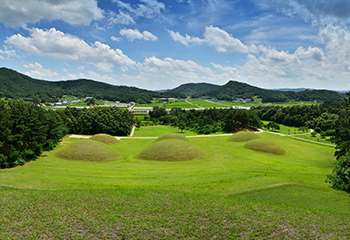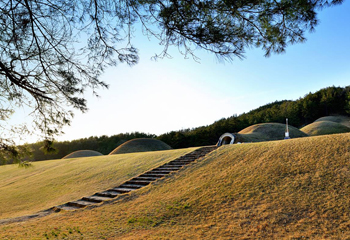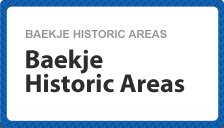Buyeo Royal Tombs
The Buyeo Royal Tombs are located just outside of the eastern part of the Naseong City Wall.
The tombs are located on the southern part of the mountain (121m high) in Neungsan-ri. Small hills are placed on the left and right of the tombs, and a small stream called Wangpocheon flows on the south of the tombs. There are a total of seven tombs at this site. Six tombs formulate two rows with three mounds per row, while one tomb is situated 50m away, to the north from of the six tombs.

Excavation of the Buyeo Royal Tombs were carried out in 1915 and 1917. The excavations revealed that these tombs had three types of stone chamber tombs with a corridor. Stone chamber tombs with a corridor were constructed during the Baekje Period, dividing into a “vault ceiling” type and a “flat ceiling” type, in terms of the construction method for the ceilings. The flat ceiling type is classified again into “hexagonal” and “square” ceilings. The excavations also found that ceiling changed from the ceiling of the vault type to the hexagonal or rectangular flat type.
Tomb No. 2 has a vault type ceiling, consisting of a rectangular stone chamber tomb with a corridor attached to the south wall. The burial chamber measures 3.21m south to north, 1.98m east to west, and is 2.15m in height. Well-trimmed rectangular stones were used to build the curved walls forming the shape of a tunnel, which is very similar to the construction methods used in Tomb No. 6 in Songsan-ri and for the Tomb of King Muryeong. The only difference was that flat stone slabs were used on the top of the walls instead of trapezoidal stone slabs.

The most distinguishing feature of Tombs No. 3 and 5 was the ceiling. These tombs were typical tomb structures, where the walls and ceiling were constructed with well-trimmed stone slabs and had a corridor connected to the south wall. However, they stood apart from the rest of tombs due to the construction method that was used to form their ceilings. The walls of these tombs were erected perpendicularly from the ground and stone slabs were placed at a 45-degree angle, before a covering stone was placed on the top of the walls as a lid to form a hexagonal shape.
Tomb No. 1 was constructed by a chamber being dug underground and by erecting three large stone slabs to form each wall to the east, west, and north. A covering stone was placed on the top of these walls, which resulted in a rectangular chamber being formed. The burial chamber measures 3.27m in length, 1.52m in width, and 1.95m in height. The four walls of this particular tomb contained murals depicting the Four Deities, while its ceiling was decorated with murals of lotus and cloud designs, all of which provide essential resources for research on paintings from the Baekje Period.
Unfortunately, the tombs in Neungsan-ri were robbed before they could be excavated. Only a few archaeological findings, such as gilt-bronze skull ornaments and waist belts, were left. In the 1990s, the Great Gilt-bronze Incense Burner of the Baekje was discovered at a temple site to the west of the Buyeo Royal Tombs, along with stone sarira reliquaries that were produced in 567. These discoveries reconfirmed that the tombs in Neungsan-ri belonged to the royal family of the Baekje during the Sabi Period.
General Status of the Buyeo Royal Tombs
| Tombs | Type of Ceiling | Materials | Size of Burial Chamber | Shapes of Plane Surface | Floor | Others |
|---|---|---|---|---|---|---|
| No. 1 | Rectangle | Polished stones | 250×112×122 | Rectangle | Stone slabs | Mural |
| No. 2 | Vault | Rectangular stones | 321×198×215 | Rectangle | Flooring stones | Lime plastering |
| No. 3 | Hexagon | Stone slabs | 285×125×150 | Rectangle | Stone slabs | - |
| No. 4 | Hexagon | Stone slabs | 325×200×211 | Rectangle | - | - |
| No. 5 | Hexagon | Stone slabs | 325×145×170 | Rectangle | - | - |
| No. 6 | Hexagon | Stone slabs | - | - | - | - |
| No. 7 | Hexagon | Stone slabs | 243×110×165 | Rectangle | Bricks | - |










